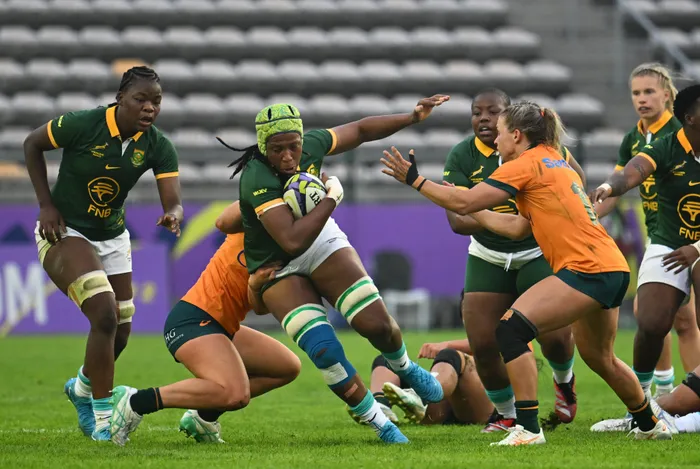
Nolusindiso Booi will captain the Springbok Women during the Women's Rugby World Cup in the coming weeks. Photo: Backpagepix
Image: Backpagepix
Feel it, it is here!
The iconic slogan of the 2010 Fifa World Cup. But now it is the time of the Women’s Rugby World Cup, set to kick off at Sunderland’s Stadium of Light on Friday when hosts England face the USA.
The oval-ball game has traditionally been the domain of big, brutish men. But for the next month, women will take centre stage.
There will be physical contests up front, but also skill and speed on show that will capture audiences’ attention. And it is this new fan base that excites me. According to a report released by World Rugby, the Women’s Rugby World Cup England 2025 is forecast to attract up to 400 000 attendees and 50 million global viewing hours.
The report includes staggering numbers: 49% of fans have joined in the last two years, engagement is up 65% over the past four years, with South African supporters in particular leading the way with a 72% rise, followed by the USA’s 69%.
While South Africa’s sharp rise in engagement may reflect a late awakening here in Mzansi, it also points to the country’s intentional shift towards supporting women’s sport across codes. The success of the Proteas Women’s cricket side and Banyana Banyana has undoubtedly had a knock-on effect on the Bok Women.
Fans are also younger (29% under 35), more gender-balanced (43% female), and family-oriented (50% with children), with half of fans citing increased broadcast and digital visibility as their entry point into the sport.
We in the media have always had a moral responsibility to grow the women’s game. Now, it has become commercially viable, with merchandise-buying women’s rugby fans spending 16% more than men’s rugby fans.
I could not agree more with World Rugby Chief of Women’s Rugby Sally Horrox, who believes the sport is on the brink of transformation.
“Women’s rugby stands on the brink of something extraordinary. Powered by world-class athletes, a passionate and growing fanbase, and a global calendar featuring Women’s Rugby World Cups in England, Australia and the US, the sport represents one of the most dynamic opportunities in global sport. Unlocking its full potential requires strategic focus, sustained investment, and collective commitment,” Horrox said.
The Springbok Women are unlikely to emulate Siya Kolisi’s men’s team by lifting the trophy. It is simply too early in their development. But they are capable of making history by becoming the first Bok Women’s team to reach the knockout stages.
Swys de Bruin’s side opens their campaign on Sunday against Brazil in Northampton before facing Italy in York the following week. Their final group match is against heavyweights France on September 7 at Franklin’s Gardens.
is a tough schedule, but the Boks have shown positive signs in their build-up with fiercely contested matches against world No 2 Canada and New Zealand’s Black Ferns XV.
The team’s traditional strength lies in its power-packed forwards, led by captain Nolusindiso Booi, front-rower Babalwa Latsha and rampaging No 8 Aseza Hele.
There is plenty of speed and flair in the backline too, with Nadine Roos, Eloise Webb and Cheslin Kolbe-lookalike Byrhandré Dolf set to thrill out wide.
The Springboks’ slogan for the 1995 Rugby World Cup was One Team, One Country.
Thirty years later, there is no better opportunity for South Africans to show this remains true by getting behind Booi’s charges as they aim to make the nation proud in the UK.